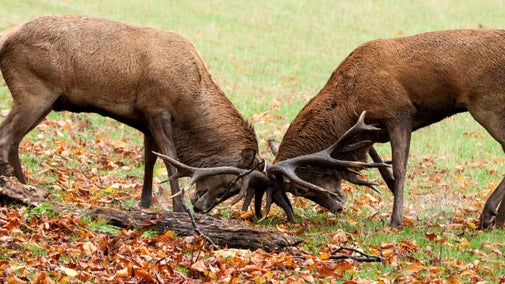
Discover more at Hatfield Forest
Find out when Hatfield Forest is open, how to get here, things to see and do and more.

Wild deer are wonderful creatures and a natural part of the British landscape. Although shy and elusive, they can often be seen at Hatfield Forest in the early morning or at dusk when they're most active. Hatfield Forest is home to herds of fallow and muntjac deer. In the autumn, listen out for fallow deer rutting in the wooded areas of the Forest.
Hatfield Forest is home to established herds of both fallow and muntjac deer. The team manage the deer population responsibly to ensure both their welfare and that of the ancient woodland habitat.
You are most likely to see deer on a forest ride, roaming from coppice to coppice and, as they show no respect for boundaries, you can also spot them in the surrounding woodlands and fields.
Fallow deer were introduced to Hatfield Forest by Henry I, in the 12th century. In those days the word 'forest' meant 'a place of deer'.
A young male fallow deer is called a pricket, an adult male a buck, a female a doe, and a young female a fawn. They have a life span of around 12 to 16 years, but only bucks have antlers. These are broad and palm-shaped from three years old.
Fallow deer live in herds. The mature bucks tend to live in outlying, satellite woodlands for the summer, only coming into the Forest in autumn for the rutting season.
Muntjac deer are secretive and shy. They are small and stocky, russet brown in summer and grey-brown in winter. Originally from Asia, they were imported into zoos in England in the 19th century and were first seen in the Forest in 1964. They eat herbs, brambles and ivy, as well as coppice shoots.
Unlike the fallow deer, they tend to be solitary creatures. They are also known as ‘barking deer’, on account of the distinctive sounds they make.

Deer enjoy eating – or 'browsing' – the leaves, shoots and even the bark of woody plants and also many different wildflowers such as the rare oxlip. They have a devastating effect on the woodland when the population outgrows the food supply. Today, wild deer have become the single biggest threat to woodland in the UK.
The shrub layer of the woodland at Hatfield Forest and neighbouring Wall Wood has been entirely eaten by the deer. This natural layer normally provides nesting habitat, shelter, nectar, berries and nuts for a whole range of birds, mammals and insects. With the shrub layer gone, all life suffers and, if wood can’t produce young trees, it will eventually die.
In larger numbers, deer need to go further for food and then cause a great deal of damage to farmers’ crops, as well as causing up to 74,000 vehicle collisions every year on the UK’s roads.
Two main problems are that deer no longer have natural predators in the UK, and that mild winters in the south have resulted in a very high birth rate. Responsible deer management is a statutory obligation for owners of ancient Sites of Special Scientific Interest (SSSI) woodland, such as Hatfield Forest.
At Hatfield Forest and Wall Wood, the damage to the ancient coppices had become unsustainable meaning a reduction cull became necessary, as well as protective deer fencing.
The team surveys the woodlands for deer impacts and undertakes an annual deer census at night with thermal imaging cameras to monitor the size of the herd. In smaller numbers, deer can be beneficial to the woodland by opening up small glades in which wildflowers and insects thrive. The maintenance of a healthy herd will always be necessary, just as it has been for the last 1,000 years.
Our professional deer management team are trained to the highest standards. You're safe walking in the Forest whilst deer management is in progress. We however recognise that some people may not wish to witness deer culling activities. For this reason, we provide the following guidelines so that an informed choice can be made as to the best times to visit:
Deer management at Hatfield Forest is supported by Natural England, the Forestry Commission, the Deer Initiative and Essex Police.
During the season, wild venison, produced from Hatfield Forest’s deer management, is sold at the Estate Office. For further information, call us on 01279 870678.

Find out when Hatfield Forest is open, how to get here, things to see and do and more.
Find out about fallow, red and muntjac deer, how to tell them apart and other top tips for seeing and photographing them at the places we care for.

Hatfield Forest is a two pawprint rated place. It's a perfect place for walking your dog, with 1,000 acres of woodland and open grassland to explore, trees to sniff and grass to roll around in. Professional dog walkers will need a National Trust license to walk a maximum of 4 dogs, up to three times a day.

Visit a royal medieval hunting ground with mighty ancient oaks, fallow deer and wildlife aplenty. Enjoy a walk followed by a treat from the Forest Café in the beautiful surroundings of the Georgian lake and Shell House.

Discover a range of outdoor activities at Hatfield Forest in Essex. From short to long walks, running routes, horse riding and fishing, there's something for everyone.

Find out about some of Hatfield Forest's rich and varied history, including how the original royal hunting forest was created and then, later, how Lancelot 'Capability' Brown left his mark.

Learn about how the team at Hatfield Forest continue to look after this special place for everyone, for ever.

Every autumn, drama unfolds as male deer lock antlers in competition for females. Find out where you can visit during deer rutting season to see one of nature's annual spectacles.
